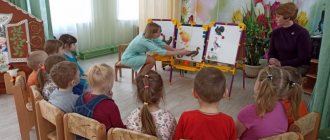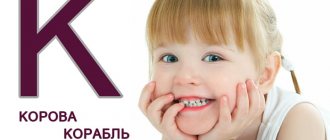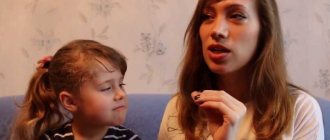Progress of the lesson:
I.
Introductory part:
1. Organizational point:
Time for business, time for fun. Listen to my story. I’ll sit up straight, I won’t bend, I’ll get to work! Check, my friend, are you ready to start the lesson? 2. Announcement of the topic and purpose of the lesson:
The topic of our lesson is “Dishes”. Let's get acquainted with the dishes.
II. Main part:
1. Game “sly spoon”.
Place utensils in front of the child: a plate (faience), a spoon (metal), a cup (glass) - and name each item. Ask the child to show objects and ask: “What is this?”
We will play with a spoon, tap the spoon on the plate: And name the dishes. "This is a plate." Knock with spoon
Close your eyes, take a cup.
Guess why the spoon is knocking? The child closes his eyes and listens to sounds.
Shows the dishes that were knocked on. Trying to give names to the dishes. (Loka, taka, cha-chaka)
2. Game "What is this."
The speech therapist invites the child to examine and show, then name the dishes (as best he can, without paying attention to articulation)
Items: teapot, cup, spoon, knife, plate. “I will... drink from a cup.” (child repeats: pp-pi)
“I’ll... eat from the plate (yum).” “I will use a knife...?” (cut-rr eat)
3. Physical exercise.
“Get up, let’s rest!”
I take the cup in my hands,
And I bring it to my mouth,
I tilt my head (performs the movements behind the speech therapist, independently)
I drink the tea to the bottom.
Well done. Sit down.
4. Game “Assignment”.
The child is standing at the table. Speech therapist: “Take a cup.” “What did you take? "
- cup. (chaku)
- "What did you do?" (took and dropped)
So continue with each of the dishes.
III.
Final part.
- Activity assessment: You were active in class. Well done, keep trying.
- Summing up: What dishes did you learn today? (child answers).
- Homework: written in an individual notebook: (play with dishes, learn to name each type)
Summary of an individual speech therapy session with a 4-year-old child.
Topic: "Wild Animals".
Purpose: to cause onomatopoeia;
Tasks:
- develop auditory attention,
- further development of the thoraco-abdominal type of breathing,
- activate vocabulary on the topic,
- develop fine motor skills and constructive praxis.
Equipment: toys or pictures with wild animals, cut-out pictures on the topic.
Differential diagnosis of motor alalia
Before starting correctional work, it is necessary to distinguish motor alalia from other disorders: sensory alalia, dysarthria, hearing loss, childhood motor aphasia, mental retardation (mental development delay) and speech development delay. The diagnosis of motor alalia is made by a neurologist no earlier than the age of four, since many mental functions in children, including speech, are in the process of formation. The speech therapist evaluates the sound pronunciation and prosodic side of speech in order to make a psychological and pedagogical conclusion: GRR, GSD (general speech underdevelopment) of level I, II or III. Before the age of 4 years, the diagnosis of RRD is usually made, but some signs of motor alalia can be seen from infancy.
| On first stage Anamnestic data is being collected to clarify the medical history. They find out whether the child previously had any speech or not. This makes it possible to distinguish motor alalia from childhood motor aphasia, since aphasia is the loss of existing speech, while alalia is the absence of speech from birth. A characteristic feature of motor alaliks is the absence of even babbling speech, which normally appears in a child from 5-6 months. They also find out the possible cause of the disease: asphyxia, birth trauma, infectious diseases of the mother or child, traumatic brain injuries of the child, etc. The purpose of clarification is to establish whether the disorder is organic or functional in nature and to distinguish it from ZRR. |
| Second phase – examination of speech understanding on the basis of differentiation from sensory alalia, in which the child’s perception and understanding of speech is grossly impaired. The motor alalik perceives and understands speech according to age. The child is shown pictures or toys and asked: show me where... |
| Third stage – hearing testing to differentiate from hearing loss and deafness. In motor alaliks, the auditory function is preserved, while in those with hearing impairments it is impaired. The child is asked to guess with his eyes closed what sounds (non-speech sounds): rattle, tambourine, rustling paper, bell, etc. In addition, the prosodic components of speech are checked. Non-speaking alaliks, usually even without words, with the help of sounds, can convey intonation, melody, stress, rhythm of speech without gestures; children with hearing impairment are not able to reproduce the intonation pattern verbally; they use facial expressions and gestures. |
| On fourth stage study the child’s facial expressions: moving or static. In motor alaliks, in the absence of speech, facial expressions are very active, expressive; in dysarthric and sensory alaliks, sluggish facial expressions, amicity, spasticity of the articulation organs are observed; they cannot raise an eyebrow, puff out their cheeks, stretch their lips in a smile and stretch them out like a tube. The same test samples are used as for dysarthria. |
| Fifth stage includes an examination of the articulatory organs in order to also differentiate motor alalia from dysarthria, in which the articulatory apparatus usually suffers. With motor alalia, the tongue, lips, teeth, and soft palate are usually normal. With dysarthria, there is an increased or decreased tone of the tongue, spasticity or pareticity of the lips, tongue, and soft palate. |
| On the sixth At this stage, the sound pronunciation of existing phonemes is checked. Usually, with motor alalia, there can be both correct and distorted pronunciation of sounds; with dysarthria, all distorted sounds are constantly distorted. |
| Seventh stage – examination of mental functions. With motor alalia, a child develops negativism towards verbal communication, lacks motivation for activity, withdraws into himself, has difficulty making contact with strangers, which cannot be said about a child with mental retardation, who has developed motivation for action and the ability to master independent speech. |
How to correct sensory alalia
It is necessary to correct sensory alalia only using an integrated approach. It consists of:
- medications prescribed by a neurologist;
- neurocorrection;
- classes with a speech pathologist;
- classes with a speech therapist;
- working with a child psychologist;
- physiotherapy, occupational therapy;
- special speech therapy massage.
Comprehensive assistance
Doctors prescribe nootropic drugs, neuropeptides, neuroprotectors, vitamins. These drugs have a positive effect on the central nervous system as a whole. Additional measures may include massages, exercise therapy, and medicinal baths.
Logotherapy
The goal here is the formation of auditory perception, the development of the ability to analyze the speech and words of others. In the first stages, the baby’s chaotic speech slows down, his perseverance and attentiveness increase.
Neuropsychological correction
Here, the development of deficit functions and thinking occurs, the baby’s memory improves, and activity appears in exploring the world around them. All these treatment components are selected and prescribed by specialists, taking into account age, severity of the disease, causes and a number of other physiological characteristics. A prerequisite for successful therapy is training with a speech pathologist.
Corrective measures can be selected only after a comprehensive diagnosis. The outcome of therapy depends on the timing of detection of this speech disorder. The optimal age when it is desirable to begin correction is considered to be 2-3 years.
Treatment prognosis and preventive measures
The prognosis of the result is determined by how early the problem was identified and only the doctor who is caring for the baby can talk about it. Logotherapy will help only if the entire plan of correctional work, consisting of a medical as well as a psychological component, is followed.
Timely initiation of therapy and strictly observed correction make it possible to smooth out disorders of the speech apparatus and prevent deviations in the future.
In case of late application, the likelihood of receiving a fully formed speech is sharply reduced. In the absence of corrective measures, speech delay can lead to poor socialization of the baby. As a result, psychological disorders may appear. Measures to prevent sensory alalia are carried out during pregnancy, and then at an early age of the baby.
Differences between sensory alalia and the motor type of speech impairment
Auditory attention with this disorder is reduced or completely absent. The speech of adults is perceived indistinctly, as a set of chaotic sounds
Therefore, there is no desire to imitate, repeat words, syllables, sounds.
Children with sensory alalia have increased speech activity. This distinguishes them from children with a motor type of speech disorder. Children with a sensory type talk a lot, maintaining the correct intonation.
Often the correlation between heard and spoken words is not formed. The name cannot be assigned to a specific item. Children with normal speech apparatus development remember the name of an object after 3-5 repetitions.
For alaliq with a sensory type of disease, this requires a minimum of 25-30 repetitions. The child cannot repeat the word spoken by the parent. Adults regard this as stubbornness on the part of the child.
The degree of impairment of understanding may vary. There may be a complete misunderstanding of speech, or a misunderstanding of individual sounds and words. Understanding speech is situational. One phrase can be understood in different ways.
Sensory alalia is increased speech activity with low understanding of it by others. The baby has poor control over his own speech. Symptoms of sensory alalia:
- high excitability;
- poor behavior control;
- secondary delay in intellectual development.
Children suffering from this disorder have difficulty interacting with other people. It is difficult to influence them with words and beliefs, it is difficult for them to explain something. These factors explain the baby's uncontrollability.
It is typical for a sensory type that even specialists can often confuse it with autism. In the professional circle of speech therapists, there is an opinion to replace the term “sensory alalia” with “sensory disintegration.” Therapy for this disease begins with the sensory component. This is dictated by the fact that the child first begins to develop an understanding of speech, and only after that does the ability to pronounce sounds and words appear.
Alalia in children - symptoms, prognosis
Signs of alalia in children vary from person to person. In each case, the pediatrician identifies a number of typical symptoms and carries out diagnostic procedures. At the initial stage of the examination, the specialist must check the child’s reactions. He analyzes the baby’s reaction to being addressed, his reaction to gestures and attempts to start a dialogue. If at some point the child experiences a delay in response, the doctor diagnoses alalia, and individual treatment is prescribed for children.
Symptoms depend on the type of disease and the degree of deviation, but there are general symptoms:
- problems with fine motor skills;
- disorders of the vestibular apparatus;
- difficulties with coordination of movements;
- stuttering.
Motor alalia in children - signs
Motor alalia in children (expressive) is the inability to form letters into words due to motor impairments. A child simply cannot master language operations due to underdevelopment of the speech organs. Such children know how to move their tongues and lick ice cream, but the baby cannot fulfill the parents’ request and raise their tongue up to the sky. Children with motor alalia understand adult speech, but due to problems with the speech apparatus, they cannot express their thoughts in words. Against the background of the disease, a lag in intellectual development develops.
Motor alalia is divided into 2 types:
- Efferent.
Here the disease manifests itself due to the inhibition of the development of Broca's center (posterior lower part in the frontal lobe). - Afferent.
In this case, there is dysfunction of the lower parietal segment, located in the left hemisphere.
How does the speech of a child with motor alalia differ and what are the symptoms of the disease:
- the child begins to pronounce the first words late (at about the age of 4 years);
- vocabulary is very small;
- poor coordination of movements is noticeable;
- the child is unable to construct sentences correctly and inflect words according to cases;
- deviations in behavior are observed (hyperactivity, inactivity or inattention);
- the child becomes withdrawn and reacts aggressively to attention.
Sensory alalia in children - signs
Sensory alalia in children is a disease that must be treated at the first sign. The sensory type of disorder is characterized by damage to the cerebral cortex in the part that is responsible for speech analysis. The child cannot associate the sound designation with the image presented visually in front of him. To put it simply, the baby simply does not understand speech, although he hears it perfectly.
How does the speech of a child with sensory alalia differ, and what do its symptoms look like:
- the child constantly talks, but due to incoherent speech no one can understand him;
- the baby does not perceive speech well;
- intellectual underdevelopment gradually progresses;
- the child swaps letters in the simplest words;
- combines several words into one;
- contradictory sides of character appear - impulsiveness borders on depression, and isolation borders on activity;
- The baby is unable to mentally select names for the objects around him.
Sensorimotor alalia in children - signs
Sensorimotor alalia in children is a mixed type of disease, considered the most serious and dangerous. With this form of pathology, the baby not only does not understand what his parents or peers are saying to him, but also cannot speak on his own. Alalia in children in this form is characterized by damage to the sensorimotor area of the cerebral cortex. The pathology is treatable, but an integrated approach is required, and the sooner parents notice deviations from the norm, the more effective the treatment will be.
Signs of sensorimotor alalia in children:
- a child under 3 years old does not speak a word;
- violations in the field of social adaptation are observed;
- the baby is afraid of loud sounds;
- there are difficulties in forming speech, including substitution of letters in simple words;
- poor vocabulary;
- Difficult understanding of speech addressed to a child.
Severity of alalia
Degrees of speech underdevelopment are divided into 2 types:
- Easy.
With this degree of severity, it is necessary to invite a speech therapist and complete all homework. Deviations are quickly corrected, and the child will learn to care for himself and speak. - Heavy.
This degree is characterized by severe lesions of the speech centers in the brain. Treatment includes drug therapy, but even with an integrated approach, improvements are extremely rare.





![Producing the sound [L] to a child in stages. Articulation gymnastics, speech therapy exercises, pronunciation lessons with pictures](https://doktorobrubov.ru/wp-content/uploads/postanovka-zvuka-l-rebenku-poetapno-artikulyacionnaya-gimnastika-logopedicheskie-uprazhneniya-uroki-330x140.jpg)


